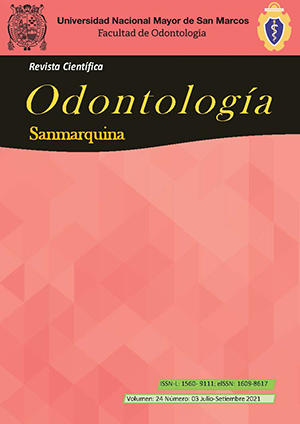Functional orthopedic jaw and orthodontic treatment in a patient with fragile-X syndrome. A case report
DOI:
https://doi.org/10.15381/os.v24i3.20718Keywords:
Fragile X syndrome, Dentistry, Intellectual disability, Corrective orthodontics, Dental care for disabledAbstract
The Fragile-X Syndrome (FXS) is a disorder linked to X chromosome, on the long arm Xq27.3, causing several changes such as behavioral problems, intellectual disability, macroorchidism, large and prominent auricles, deep and ogival palate, mandibular prognathism, increased mandibular angle, malocclusion, and dental anomalies. The objective was to present a case of a 16-year-old patient with FXS, leukoderma, submitted to orthopedic functional maxillary treatment to correct dental crowding. In general, clinical examination, behavioral changes such as shyness, anxiety, emotional lability, sporadic disturbances of behavior associated with mild mental disabilities were remarkable. After panoramic radiographic evaluation and cephalometric tracings, it was decided to install the functional orthopedic appliance of the jaws, Indirect Flat Planes type, for later corrective orthodontic treatment. At beginning of treatment, there was a difficulty in understanding and collaborating, not only from the patient’s side but also from the mother’s. After five months, even with the improvement in stomatognathic functions, orthodontic treatment with a fixed appliance was started, which was concluded after two years. Success of functional and / or orthodontic jaw orthopedics treatment, especially in FXS, is based on behavioral approach and motivation in all stages, by the professional as well as a collaborative family environment.
Downloads
Downloads
Published
Issue
Section
License
Copyright (c) 2021 Aida Sabbagh-Haddad, Patrícia Valéria Cunha Georgevich, Monica Salfatis, Denise Sabbagh Haddad

This work is licensed under a Creative Commons Attribution 4.0 International License.
AUTHORS RETAIN THEIR RIGHTS:
a. Authors retain their trade mark rights and patent, and also on any process or procedure described in the article.
b. Authors retain their right to share, copy, distribute, perform and publicly communicate their article (eg, to place their article in an institutional repository or publish it in a book), with an acknowledgment of its initial publication in the Odontología Sanmarquina.
c. Authors retain theirs right to make a subsequent publication of their work, to use the article or any part thereof (eg a compilation of his papers, lecture notes, thesis, or a book), always indicating the source of publication (the originator of the work, journal, volume, number and date).






